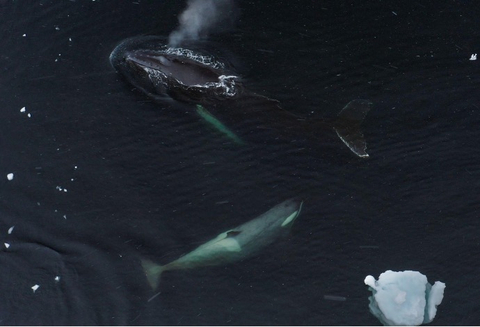The Award-Winning Cinematographer Captured Humpback Whales Interrupting Type B1 Killer Whales Hunting a Weddell Seal
This Breathtaking, Rare Moment Is for
ANIMALS UP CLOSE WITH BERTIE GREGORY,
Streaming on Disney+ on Sept. 13
Link to Clip: https://youtu.be/QzgH4A_AOE0
Embed Code: <iframe width="560" height="315" src="https://www.youtube.com/embed/QzgH4A_AOE0" title="YouTube video player" frameborder="0" allow="accelerometer; autoplay; clipboard-write; encrypted-media; gyroscope; picture-in-picture; web-share" allowfullscreen></iframe>
This press release features multimedia. View the full release here: https://www.businesswire.com/news/home/20230907053396/en/

Credit: National Geographic for Disney+/Bertie Gregory
WHO / WHAT: While on expedition off the icy coast of Antarctica to film the very rare type B1 killer whales — it’s estimated there are only 100 alive today — National Geographic Explorer and BAFTA Award-winning cinematographer Bertie Gregory (@BertieGregory) filmed two humpback whales interfering as B1 orcas hunted their favorite prey: the Weddell seal, which can weigh up to 1200 pounds. The whales swam over to the site of the attack to disrupt the killer whales from capturing the seal, though they ultimately failed to save its life.
This fascinating moment revealed a phenomenon where one species of marine animal appears to be trying to protect another. Scientists believe that because killer whales occasionally take humpback whale calves for food, this drives the adult humpbacks to try to stop any killer whale hunt they come across. This extraordinary interaction between B1 killer whales and humpback whales can be seen in the “Antarctic Killer Waves” episode of the new natural history series ANIMALS UP CLOSE WITH BERTIE GREGORY. Learn more about this breaking news at NatGeo.com.
WHEN: January 2022 in Antarctica.
WHERE: Bertie and his team sailed for seven days on a 1000-mile boat journey across one of the roughest stretches of ocean on Earth, the Drake Passage, from South America and south along the Antarctic peninsula. Once there, they ventured further to the Gullet — a beautiful, difficult-to-navigate narrow channel that led them to an impassable ice sheet deep in Antarctica. As winter turns to spring, chunks of ice break off from these ice sheets and drift down the Gullet, enabling Weddell seals to use them as a place to rest between feeds.
WHY: To film the B1s employing sophisticated hunting tactics such as wave washing, where they work together to create a huge wave that forces a seal off the ice sheet and into the water. Type B orcas are the only species to do this. Orcas are highly intelligent predators. They also swim under ice floes in fast formation, causing enough force to shatter the ice and further strand their prey, which is what Bertie was witnessing when the humpbacks interrupted.
HOW: To capture this rarely filmed behavior, Bertie utilized state-of-the-art drones from the air, and the team used a gyro-stabilized camera to capture steady shots of the action from the boat.
MANDATORY MENTIONS: All episodes of the Disney+ Original series from National Geographic ANIMALS UP CLOSE WITH BERTIE GREGORY will stream on Disney+ on Sept. 13.
VISUALS AVAILABLE: High-res images available HERE. Video available HERE.
#AnimalsUpClose | #DisneyPlus | #NatGeo
Instagram: @DisneyPlus | @NatGeoTV | @BertieGregory
TikTok: @DisneyPlus | @NatGeo | @BertieGregory
X: @DisneyPlus | @NatGeoTV | @BertieGregory
Facebook: @DisneyPlus | @NatGeoTV | @BertieGregory
For more information on the series, please visit: https://press.disneyplus.com/media-kits/animals-up-close-with-bertie-gregory
View source version on businesswire.com: https://www.businesswire.com/news/home/20230907053396/en/
Contacts
National Geographic PR
Jennifer Driscoll
Jennifer.Driscoll@natgeo.com
